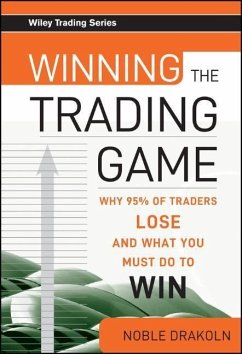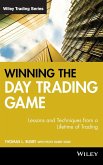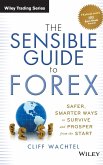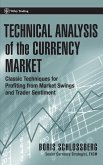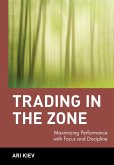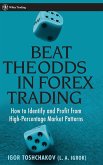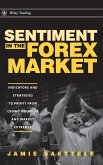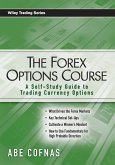Noble DraKoln
Winning the Trading Game
Noble DraKoln
Winning the Trading Game
- Gebundenes Buch
- Merkliste
- Auf die Merkliste
- Bewerten Bewerten
- Teilen
- Produkt teilen
- Produkterinnerung
- Produkterinnerung
With Winning the Trading Game, investment expert Noble DraKoln helps you develop and refine the mental discipline and practical skills needed to ensure trading success.
Der Zweck dieses Buches ist es, angehenden Kaufleuten die mentale Disziplin und praktischen Fertigkeiten, die von erfahrenen und professionellen Händlern genutzt werden, beizubringen. Es wird erklärt, wie man die drei wesentlichen Fertigkeiten des Handels meistert: Money-Management, technische Analyse, Risiko und Kontrolle. Das Ziel dabei ist, die Spielermentalität des "wahllos Aussuchena" durch eine Reihe richtiger…mehr
Andere Kunden interessierten sich auch für
![Winning the Day Trading Game Winning the Day Trading Game]() Thomas L. BusbyWinning the Day Trading Game52,99 €
Thomas L. BusbyWinning the Day Trading Game52,99 €![The Sensible Guide to Forex The Sensible Guide to Forex]() Cliff WachtelThe Sensible Guide to Forex50,99 €
Cliff WachtelThe Sensible Guide to Forex50,99 €![Technical Analysis of the Currency Market Technical Analysis of the Currency Market]() Boris SchlossbergTechnical Analysis of the Currency Market55,99 €
Boris SchlossbergTechnical Analysis of the Currency Market55,99 €![Trading in the Zone Trading in the Zone]() Ari KievTrading in the Zone48,99 €
Ari KievTrading in the Zone48,99 €![Beat the Odds in Forex Trading Beat the Odds in Forex Trading]() I. R. ToshchakovBeat the Odds in Forex Trading48,99 €
I. R. ToshchakovBeat the Odds in Forex Trading48,99 €![Sentiment in the Forex Market Sentiment in the Forex Market]() Jamie SaetteleSentiment in the Forex Market57,99 €
Jamie SaetteleSentiment in the Forex Market57,99 €![The Forex Options Course The Forex Options Course]() Abe CofnasThe Forex Options Course48,99 €
Abe CofnasThe Forex Options Course48,99 €-
-
-
With Winning the Trading Game, investment expert Noble DraKoln helps you develop and refine the mental discipline and practical skills needed to ensure trading success.
Der Zweck dieses Buches ist es, angehenden Kaufleuten die mentale Disziplin und praktischen Fertigkeiten, die von erfahrenen und professionellen Händlern genutzt werden, beizubringen. Es wird erklärt, wie man die drei wesentlichen Fertigkeiten des Handels meistert: Money-Management, technische Analyse, Risiko und Kontrolle. Das Ziel dabei ist, die Spielermentalität des "wahllos Aussuchena" durch eine Reihe richtiger Handelssysteme zu ersetzen, die den Händler sowohl durch Gewinn als auch Verlust führen. Sobald der Durchschnittsanleger diese neuen Fähigkeiten erlernt hat, ist er oder sie in der Lage, die Kontrolle über Futures und Forex zu gewinnen, so wie die Profis es schon immer getan haben.
Der Zweck dieses Buches ist es, angehenden Kaufleuten die mentale Disziplin und praktischen Fertigkeiten, die von erfahrenen und professionellen Händlern genutzt werden, beizubringen. Es wird erklärt, wie man die drei wesentlichen Fertigkeiten des Handels meistert: Money-Management, technische Analyse, Risiko und Kontrolle. Das Ziel dabei ist, die Spielermentalität des "wahllos Aussuchena" durch eine Reihe richtiger Handelssysteme zu ersetzen, die den Händler sowohl durch Gewinn als auch Verlust führen. Sobald der Durchschnittsanleger diese neuen Fähigkeiten erlernt hat, ist er oder sie in der Lage, die Kontrolle über Futures und Forex zu gewinnen, so wie die Profis es schon immer getan haben.
Produktdetails
- Produktdetails
- Wiley Trading Series
- Verlag: Wiley & Sons
- 1. Auflage
- Seitenzahl: 304
- Erscheinungstermin: 1. Juni 2008
- Englisch
- Abmessung: 233mm x 167mm x 27mm
- Gewicht: 500g
- ISBN-13: 9780470169957
- ISBN-10: 0470169958
- Artikelnr.: 23348314
- Herstellerkennzeichnung
- Libri GmbH
- Europaallee 1
- 36244 Bad Hersfeld
- gpsr@libri.de
- Wiley Trading Series
- Verlag: Wiley & Sons
- 1. Auflage
- Seitenzahl: 304
- Erscheinungstermin: 1. Juni 2008
- Englisch
- Abmessung: 233mm x 167mm x 27mm
- Gewicht: 500g
- ISBN-13: 9780470169957
- ISBN-10: 0470169958
- Artikelnr.: 23348314
- Herstellerkennzeichnung
- Libri GmbH
- Europaallee 1
- 36244 Bad Hersfeld
- gpsr@libri.de
Noble DraKoln (Long Beach, CA, USA) ist Präsident der Liverpool Derivatives Group Inc.
Preface xv
Acknowledgments xix
Part I More Life at the End of Your Money 1
Chapter 1 The Need to Build Wealth 3
Retiring Early 4
Negative Savings Rate 5
Social Security 6
Conclusion 8
Chapter 2 Money-Making Megatrends 11
Industrialization 12
Emerging Markets 13
China 13
India 14
Brazil 14
Russia 15
Mexico 15
Other Emerging-Market Countries 16
Resources under Fire 16
Food 17
Water 17
Energy 18
Ethanol-The Gasoline Alternative 19
Futures, Forex, or Stocks? 20
Chapter 3 What Type of Investor Are You? 23
Yale Study 24
What Are the Returns to Investing in Commodity Futures, and How Do These
Returns Compare to Investing in Stocks and Bonds? 24
Are Commodity Futures Riskier Than Stocks? 25
Can Commodity Futures Provide Diversification to Other Asset Classes? 25
Pros and Cons 25
Types of Investors 26
Type A Investor 26
Type B Investor 30
Fatal Market Conditions 32
Gold and Silver Cornering 32
Interest Rate Backfire 33
Asian Flu 34
Where You Fit in 35
Part II Why 95% of Investors Fail at Futures and Forex 37
Chapter 4 The World of Futures and Forex 39
Futures and Options 40
Hedgers and Speculators 41
Futures Exchanges 42
What Markets Are Traded? 44
Foreign Exchange (Forex) 44
What Is the Spot Market? 45
Importers and Exporters 45
OTC Forex Contracts 47
How Is the Spot Price Calculated? 47
OTC Participants 48
Components of OTC Contracts 49
Types of Positions and Orders 49
Positions 49
Types of Orders 50
Options 50
Option Rights vs. Obligations 50
Premiums 51
Time 51
Types of Options 52
Conclusion 53
Chapter 5 The Fallacy of Traditional Stock Investment Beliefs 55
Futures and Forex Investing Is Not New 56
What You Don't Know Can Hurt You 57
Explaining the Strategies 58
Buy and Hold 58
Dollar Cost Averaging 60
Value Investing 61
Portfolio Diversification 63
Margin 65
Don't Short the Market! 66
Fear Leverage! 68
Good Use of Leverage 68
Neutral Use of Leverage 69
Bad Use of Leverage 69
Myth Busting 69
Chapter 6 How to Be Among the 5% Who Win at Trading 71
The Reality 71
Trading with Emotions 72
In the Beginning: Happiness 72
Next Comes: Greed 72
Followed Up by: Fear 73
Which Leads to: Sorrow 73
Next You Have: Frustration 74
Finally: Defeat 74
What the Other 5% Are Doing 75
Selecting Trades Properly 75
Entering Trades Properly 76
Monitoring the Trade 76
Exiting the Trade 77
Battling the Demons of Fear and Greed 77
Holding Losing Trades 78
Chasing Markets 78
Overleveraging Your Account 79
So What Does It Take to Be a 5% Trader? 80
Chapter 7 Becoming a Speculator 81
Speculation vs. Gambling 82
Let's Define Gambling Addiction 83
Could Trading Represent a Form of "Gambling Addiction" for You? 83
10 Symptoms of Gambling Addiction 85
Seeking Assistance 87
TheRoleofaSpeculator 87
Are You a Sucker or a Speculator? 88
The Three Keys to Success 90
Money Management 91
Technical Analysis 91
Risk Management 92
Using the Keys to Map Out Your Journey 92
Trading Plan 93
Trade Worksheet 101
Trade Journal 101
Pulling It All Together 103
Part III Seven Lessons for Trading Success 105
Chapter 8 Lesson 1: Developing a Trading Plan 107
Myths of Trading 110
What Markets Should You Trade? 112
1. Get a Margin Sheet of All of the Tradable Markets 113
2. Understand Initial Margin and Maintenance Margin 119
3. Figure Out Which Markets Have Margins Less Than Your Account 120
4. Learn Minimum Tick or Point Values of Those Markets 120
5. Determine Average True Range to Choose Acceptable Volatility 121
6. Organize "Short-Listed" Markets from Least to Most Volatile 122
7. Check the "Open Interest" for Each Market to Find the Most Liquid 123
What You Have Accomplished 129
Chapter 9 Lesson 2: Preparing to Speculate 131
Your Money, Your Emotions 133
Defining Fear 133
Overcoming Fear 136
Defining Greed 136
Overcoming Greed 140
Setting Trading Goals for Yourself 140
Why Am I Investing in Futures/Forex? 141
What Percentage Return Am I Looking For? 142
When Will I Know If I Have Succeeded? 143
Money Management Rules 144
Your Capital 145
Your Account 146
Your Trades 147
Conclusion 148
Chapter 10 Lesson 3: Choosing Your Technical Indicators 151
Fundamental versus Technical Analysis 152
Why Technical Analysis Works 153
Technical Analysis Strengths and Weaknesses 155
Strengths 155
Weaknesses 156
Questions for Technical Indicators 158
Where Is the Market Going? 158
How Quickly Is It Getting There? 163
When Has It Arrived? 168
Liverpool Trader Checklist 172
Black Box and Systems Trading 173
Chapter 11 Lesson 4: Developing Tactics for Entering and Exiting the Market
175
Five Tools for Entry/Exit 177
Resistance and Support 177
Fibonacci Retracements 181
Average True Range 183
Moving Average 184
Candlestick Patterns 187
Trading Is a Team Sport 195
Chapter 12 Lesson 5: Analyzing Your Opponents and the Market 197
Market Players 201
Hedging Examples 202
Contango and Backwardation 203
Speculators 206
Sophisticated Speculators 207
Ground Rules for Speculators Using Hedging Techniques as a Risk Management
Strategy 207
Examples of Why Hedging Can Be Important 208
What Can We Learn? 211
Analyzing the Markets: Volume, Open Interest, and Liquidity 212
Mastering Fundamental Reports 214
Tip for Active Traders 215
Tip for Swing Traders 215
Position Traders 215
Conclusion 216
Chapter 13 Lesson 6: Managing Risk 217
Stock Investment Truisms 218
What You Should Believe 219
Belief 1: Being Both Long and Short the Market Is Not the Same as Being
Neutral the Trade 219
Belief 2: These Markets Were First Designed as Insurance Vehicles, Not to
Be Speculated On 220
Belief 3: It Is Too Difficult to Understand/Learn 220
Belief 4: There Are Only Three Ways the Market Can Move: Up, Down, and
Sideways 220
Success and Failure in Trading 221
What Makes It Different from Money Management 223
Don't Expect a Miracle 224
Stops-A Bad Habit 225
Power of the Limit Order 227
Determine What Type of Trader You Are 227
Day Trader 228
Swing Trader 228
Position Trader 228
What Risk Management tools Can Do for You 229
Nine Risk Management Tactics 229
1. Synthetics 231
2. Spread Trading 235
3. Hard Stops 237
4. Covered Option 239
5. Hedges 241
6. Collars 243
7. Straddles 245
8. Strangles 247
9. Ratio Spreads 248
Risk Management Tools Best Suited for Your Trading Style 250
Proper Risk Management 251
Chapter 14 Lesson 7: Building Confidence 253
10 Mistakes All Traders Make 254
1. Misuse Leverage 254
2. Confuse Speculation with Gambling 255
3. Improperly Funding Account 255
4. Choosing Costs over Quality 256
5. Misunderstanding the Differences of Trading 256
6. Trading without a Plan 257
7. Not Keeping Records of Your Trading 257
8. Looking for Trading Confirmations 257
9. Options Are Not the Only Leveraged Investment 258
10. Lack of Understanding Regarding Money Management 258
Demo Accounts and Paper Trading 258
Test Account 260
Trading Plan, Trade Worksheet, and Trading Journal 261
Trading Plan 261
Trade Worksheet 263
Trading Journal 263
Building Confidence Isn't Easy 264
Chapter 15 Getting Started (The Three-Month Plan) 265
Four Steps to Seven Lessons 266
Money Management 267
Technical Analysis 268
Risk Management 269
Pulling It All Together 270
Three Months of Work 271
Month 1: Structure 272
Month 2: Trial and Error 272
Month 3: Perfecting Your Trading 273
What I Want for You as a Trader 274
About the Author 277
Index 279
Acknowledgments xix
Part I More Life at the End of Your Money 1
Chapter 1 The Need to Build Wealth 3
Retiring Early 4
Negative Savings Rate 5
Social Security 6
Conclusion 8
Chapter 2 Money-Making Megatrends 11
Industrialization 12
Emerging Markets 13
China 13
India 14
Brazil 14
Russia 15
Mexico 15
Other Emerging-Market Countries 16
Resources under Fire 16
Food 17
Water 17
Energy 18
Ethanol-The Gasoline Alternative 19
Futures, Forex, or Stocks? 20
Chapter 3 What Type of Investor Are You? 23
Yale Study 24
What Are the Returns to Investing in Commodity Futures, and How Do These
Returns Compare to Investing in Stocks and Bonds? 24
Are Commodity Futures Riskier Than Stocks? 25
Can Commodity Futures Provide Diversification to Other Asset Classes? 25
Pros and Cons 25
Types of Investors 26
Type A Investor 26
Type B Investor 30
Fatal Market Conditions 32
Gold and Silver Cornering 32
Interest Rate Backfire 33
Asian Flu 34
Where You Fit in 35
Part II Why 95% of Investors Fail at Futures and Forex 37
Chapter 4 The World of Futures and Forex 39
Futures and Options 40
Hedgers and Speculators 41
Futures Exchanges 42
What Markets Are Traded? 44
Foreign Exchange (Forex) 44
What Is the Spot Market? 45
Importers and Exporters 45
OTC Forex Contracts 47
How Is the Spot Price Calculated? 47
OTC Participants 48
Components of OTC Contracts 49
Types of Positions and Orders 49
Positions 49
Types of Orders 50
Options 50
Option Rights vs. Obligations 50
Premiums 51
Time 51
Types of Options 52
Conclusion 53
Chapter 5 The Fallacy of Traditional Stock Investment Beliefs 55
Futures and Forex Investing Is Not New 56
What You Don't Know Can Hurt You 57
Explaining the Strategies 58
Buy and Hold 58
Dollar Cost Averaging 60
Value Investing 61
Portfolio Diversification 63
Margin 65
Don't Short the Market! 66
Fear Leverage! 68
Good Use of Leverage 68
Neutral Use of Leverage 69
Bad Use of Leverage 69
Myth Busting 69
Chapter 6 How to Be Among the 5% Who Win at Trading 71
The Reality 71
Trading with Emotions 72
In the Beginning: Happiness 72
Next Comes: Greed 72
Followed Up by: Fear 73
Which Leads to: Sorrow 73
Next You Have: Frustration 74
Finally: Defeat 74
What the Other 5% Are Doing 75
Selecting Trades Properly 75
Entering Trades Properly 76
Monitoring the Trade 76
Exiting the Trade 77
Battling the Demons of Fear and Greed 77
Holding Losing Trades 78
Chasing Markets 78
Overleveraging Your Account 79
So What Does It Take to Be a 5% Trader? 80
Chapter 7 Becoming a Speculator 81
Speculation vs. Gambling 82
Let's Define Gambling Addiction 83
Could Trading Represent a Form of "Gambling Addiction" for You? 83
10 Symptoms of Gambling Addiction 85
Seeking Assistance 87
TheRoleofaSpeculator 87
Are You a Sucker or a Speculator? 88
The Three Keys to Success 90
Money Management 91
Technical Analysis 91
Risk Management 92
Using the Keys to Map Out Your Journey 92
Trading Plan 93
Trade Worksheet 101
Trade Journal 101
Pulling It All Together 103
Part III Seven Lessons for Trading Success 105
Chapter 8 Lesson 1: Developing a Trading Plan 107
Myths of Trading 110
What Markets Should You Trade? 112
1. Get a Margin Sheet of All of the Tradable Markets 113
2. Understand Initial Margin and Maintenance Margin 119
3. Figure Out Which Markets Have Margins Less Than Your Account 120
4. Learn Minimum Tick or Point Values of Those Markets 120
5. Determine Average True Range to Choose Acceptable Volatility 121
6. Organize "Short-Listed" Markets from Least to Most Volatile 122
7. Check the "Open Interest" for Each Market to Find the Most Liquid 123
What You Have Accomplished 129
Chapter 9 Lesson 2: Preparing to Speculate 131
Your Money, Your Emotions 133
Defining Fear 133
Overcoming Fear 136
Defining Greed 136
Overcoming Greed 140
Setting Trading Goals for Yourself 140
Why Am I Investing in Futures/Forex? 141
What Percentage Return Am I Looking For? 142
When Will I Know If I Have Succeeded? 143
Money Management Rules 144
Your Capital 145
Your Account 146
Your Trades 147
Conclusion 148
Chapter 10 Lesson 3: Choosing Your Technical Indicators 151
Fundamental versus Technical Analysis 152
Why Technical Analysis Works 153
Technical Analysis Strengths and Weaknesses 155
Strengths 155
Weaknesses 156
Questions for Technical Indicators 158
Where Is the Market Going? 158
How Quickly Is It Getting There? 163
When Has It Arrived? 168
Liverpool Trader Checklist 172
Black Box and Systems Trading 173
Chapter 11 Lesson 4: Developing Tactics for Entering and Exiting the Market
175
Five Tools for Entry/Exit 177
Resistance and Support 177
Fibonacci Retracements 181
Average True Range 183
Moving Average 184
Candlestick Patterns 187
Trading Is a Team Sport 195
Chapter 12 Lesson 5: Analyzing Your Opponents and the Market 197
Market Players 201
Hedging Examples 202
Contango and Backwardation 203
Speculators 206
Sophisticated Speculators 207
Ground Rules for Speculators Using Hedging Techniques as a Risk Management
Strategy 207
Examples of Why Hedging Can Be Important 208
What Can We Learn? 211
Analyzing the Markets: Volume, Open Interest, and Liquidity 212
Mastering Fundamental Reports 214
Tip for Active Traders 215
Tip for Swing Traders 215
Position Traders 215
Conclusion 216
Chapter 13 Lesson 6: Managing Risk 217
Stock Investment Truisms 218
What You Should Believe 219
Belief 1: Being Both Long and Short the Market Is Not the Same as Being
Neutral the Trade 219
Belief 2: These Markets Were First Designed as Insurance Vehicles, Not to
Be Speculated On 220
Belief 3: It Is Too Difficult to Understand/Learn 220
Belief 4: There Are Only Three Ways the Market Can Move: Up, Down, and
Sideways 220
Success and Failure in Trading 221
What Makes It Different from Money Management 223
Don't Expect a Miracle 224
Stops-A Bad Habit 225
Power of the Limit Order 227
Determine What Type of Trader You Are 227
Day Trader 228
Swing Trader 228
Position Trader 228
What Risk Management tools Can Do for You 229
Nine Risk Management Tactics 229
1. Synthetics 231
2. Spread Trading 235
3. Hard Stops 237
4. Covered Option 239
5. Hedges 241
6. Collars 243
7. Straddles 245
8. Strangles 247
9. Ratio Spreads 248
Risk Management Tools Best Suited for Your Trading Style 250
Proper Risk Management 251
Chapter 14 Lesson 7: Building Confidence 253
10 Mistakes All Traders Make 254
1. Misuse Leverage 254
2. Confuse Speculation with Gambling 255
3. Improperly Funding Account 255
4. Choosing Costs over Quality 256
5. Misunderstanding the Differences of Trading 256
6. Trading without a Plan 257
7. Not Keeping Records of Your Trading 257
8. Looking for Trading Confirmations 257
9. Options Are Not the Only Leveraged Investment 258
10. Lack of Understanding Regarding Money Management 258
Demo Accounts and Paper Trading 258
Test Account 260
Trading Plan, Trade Worksheet, and Trading Journal 261
Trading Plan 261
Trade Worksheet 263
Trading Journal 263
Building Confidence Isn't Easy 264
Chapter 15 Getting Started (The Three-Month Plan) 265
Four Steps to Seven Lessons 266
Money Management 267
Technical Analysis 268
Risk Management 269
Pulling It All Together 270
Three Months of Work 271
Month 1: Structure 272
Month 2: Trial and Error 272
Month 3: Perfecting Your Trading 273
What I Want for You as a Trader 274
About the Author 277
Index 279
Preface xv
Acknowledgments xix
Part I More Life at the End of Your Money 1
Chapter 1 The Need to Build Wealth 3
Retiring Early 4
Negative Savings Rate 5
Social Security 6
Conclusion 8
Chapter 2 Money-Making Megatrends 11
Industrialization 12
Emerging Markets 13
China 13
India 14
Brazil 14
Russia 15
Mexico 15
Other Emerging-Market Countries 16
Resources under Fire 16
Food 17
Water 17
Energy 18
Ethanol-The Gasoline Alternative 19
Futures, Forex, or Stocks? 20
Chapter 3 What Type of Investor Are You? 23
Yale Study 24
What Are the Returns to Investing in Commodity Futures, and How Do These
Returns Compare to Investing in Stocks and Bonds? 24
Are Commodity Futures Riskier Than Stocks? 25
Can Commodity Futures Provide Diversification to Other Asset Classes? 25
Pros and Cons 25
Types of Investors 26
Type A Investor 26
Type B Investor 30
Fatal Market Conditions 32
Gold and Silver Cornering 32
Interest Rate Backfire 33
Asian Flu 34
Where You Fit in 35
Part II Why 95% of Investors Fail at Futures and Forex 37
Chapter 4 The World of Futures and Forex 39
Futures and Options 40
Hedgers and Speculators 41
Futures Exchanges 42
What Markets Are Traded? 44
Foreign Exchange (Forex) 44
What Is the Spot Market? 45
Importers and Exporters 45
OTC Forex Contracts 47
How Is the Spot Price Calculated? 47
OTC Participants 48
Components of OTC Contracts 49
Types of Positions and Orders 49
Positions 49
Types of Orders 50
Options 50
Option Rights vs. Obligations 50
Premiums 51
Time 51
Types of Options 52
Conclusion 53
Chapter 5 The Fallacy of Traditional Stock Investment Beliefs 55
Futures and Forex Investing Is Not New 56
What You Don't Know Can Hurt You 57
Explaining the Strategies 58
Buy and Hold 58
Dollar Cost Averaging 60
Value Investing 61
Portfolio Diversification 63
Margin 65
Don't Short the Market! 66
Fear Leverage! 68
Good Use of Leverage 68
Neutral Use of Leverage 69
Bad Use of Leverage 69
Myth Busting 69
Chapter 6 How to Be Among the 5% Who Win at Trading 71
The Reality 71
Trading with Emotions 72
In the Beginning: Happiness 72
Next Comes: Greed 72
Followed Up by: Fear 73
Which Leads to: Sorrow 73
Next You Have: Frustration 74
Finally: Defeat 74
What the Other 5% Are Doing 75
Selecting Trades Properly 75
Entering Trades Properly 76
Monitoring the Trade 76
Exiting the Trade 77
Battling the Demons of Fear and Greed 77
Holding Losing Trades 78
Chasing Markets 78
Overleveraging Your Account 79
So What Does It Take to Be a 5% Trader? 80
Chapter 7 Becoming a Speculator 81
Speculation vs. Gambling 82
Let's Define Gambling Addiction 83
Could Trading Represent a Form of "Gambling Addiction" for You? 83
10 Symptoms of Gambling Addiction 85
Seeking Assistance 87
TheRoleofaSpeculator 87
Are You a Sucker or a Speculator? 88
The Three Keys to Success 90
Money Management 91
Technical Analysis 91
Risk Management 92
Using the Keys to Map Out Your Journey 92
Trading Plan 93
Trade Worksheet 101
Trade Journal 101
Pulling It All Together 103
Part III Seven Lessons for Trading Success 105
Chapter 8 Lesson 1: Developing a Trading Plan 107
Myths of Trading 110
What Markets Should You Trade? 112
1. Get a Margin Sheet of All of the Tradable Markets 113
2. Understand Initial Margin and Maintenance Margin 119
3. Figure Out Which Markets Have Margins Less Than Your Account 120
4. Learn Minimum Tick or Point Values of Those Markets 120
5. Determine Average True Range to Choose Acceptable Volatility 121
6. Organize "Short-Listed" Markets from Least to Most Volatile 122
7. Check the "Open Interest" for Each Market to Find the Most Liquid 123
What You Have Accomplished 129
Chapter 9 Lesson 2: Preparing to Speculate 131
Your Money, Your Emotions 133
Defining Fear 133
Overcoming Fear 136
Defining Greed 136
Overcoming Greed 140
Setting Trading Goals for Yourself 140
Why Am I Investing in Futures/Forex? 141
What Percentage Return Am I Looking For? 142
When Will I Know If I Have Succeeded? 143
Money Management Rules 144
Your Capital 145
Your Account 146
Your Trades 147
Conclusion 148
Chapter 10 Lesson 3: Choosing Your Technical Indicators 151
Fundamental versus Technical Analysis 152
Why Technical Analysis Works 153
Technical Analysis Strengths and Weaknesses 155
Strengths 155
Weaknesses 156
Questions for Technical Indicators 158
Where Is the Market Going? 158
How Quickly Is It Getting There? 163
When Has It Arrived? 168
Liverpool Trader Checklist 172
Black Box and Systems Trading 173
Chapter 11 Lesson 4: Developing Tactics for Entering and Exiting the Market
175
Five Tools for Entry/Exit 177
Resistance and Support 177
Fibonacci Retracements 181
Average True Range 183
Moving Average 184
Candlestick Patterns 187
Trading Is a Team Sport 195
Chapter 12 Lesson 5: Analyzing Your Opponents and the Market 197
Market Players 201
Hedging Examples 202
Contango and Backwardation 203
Speculators 206
Sophisticated Speculators 207
Ground Rules for Speculators Using Hedging Techniques as a Risk Management
Strategy 207
Examples of Why Hedging Can Be Important 208
What Can We Learn? 211
Analyzing the Markets: Volume, Open Interest, and Liquidity 212
Mastering Fundamental Reports 214
Tip for Active Traders 215
Tip for Swing Traders 215
Position Traders 215
Conclusion 216
Chapter 13 Lesson 6: Managing Risk 217
Stock Investment Truisms 218
What You Should Believe 219
Belief 1: Being Both Long and Short the Market Is Not the Same as Being
Neutral the Trade 219
Belief 2: These Markets Were First Designed as Insurance Vehicles, Not to
Be Speculated On 220
Belief 3: It Is Too Difficult to Understand/Learn 220
Belief 4: There Are Only Three Ways the Market Can Move: Up, Down, and
Sideways 220
Success and Failure in Trading 221
What Makes It Different from Money Management 223
Don't Expect a Miracle 224
Stops-A Bad Habit 225
Power of the Limit Order 227
Determine What Type of Trader You Are 227
Day Trader 228
Swing Trader 228
Position Trader 228
What Risk Management tools Can Do for You 229
Nine Risk Management Tactics 229
1. Synthetics 231
2. Spread Trading 235
3. Hard Stops 237
4. Covered Option 239
5. Hedges 241
6. Collars 243
7. Straddles 245
8. Strangles 247
9. Ratio Spreads 248
Risk Management Tools Best Suited for Your Trading Style 250
Proper Risk Management 251
Chapter 14 Lesson 7: Building Confidence 253
10 Mistakes All Traders Make 254
1. Misuse Leverage 254
2. Confuse Speculation with Gambling 255
3. Improperly Funding Account 255
4. Choosing Costs over Quality 256
5. Misunderstanding the Differences of Trading 256
6. Trading without a Plan 257
7. Not Keeping Records of Your Trading 257
8. Looking for Trading Confirmations 257
9. Options Are Not the Only Leveraged Investment 258
10. Lack of Understanding Regarding Money Management 258
Demo Accounts and Paper Trading 258
Test Account 260
Trading Plan, Trade Worksheet, and Trading Journal 261
Trading Plan 261
Trade Worksheet 263
Trading Journal 263
Building Confidence Isn't Easy 264
Chapter 15 Getting Started (The Three-Month Plan) 265
Four Steps to Seven Lessons 266
Money Management 267
Technical Analysis 268
Risk Management 269
Pulling It All Together 270
Three Months of Work 271
Month 1: Structure 272
Month 2: Trial and Error 272
Month 3: Perfecting Your Trading 273
What I Want for You as a Trader 274
About the Author 277
Index 279
Acknowledgments xix
Part I More Life at the End of Your Money 1
Chapter 1 The Need to Build Wealth 3
Retiring Early 4
Negative Savings Rate 5
Social Security 6
Conclusion 8
Chapter 2 Money-Making Megatrends 11
Industrialization 12
Emerging Markets 13
China 13
India 14
Brazil 14
Russia 15
Mexico 15
Other Emerging-Market Countries 16
Resources under Fire 16
Food 17
Water 17
Energy 18
Ethanol-The Gasoline Alternative 19
Futures, Forex, or Stocks? 20
Chapter 3 What Type of Investor Are You? 23
Yale Study 24
What Are the Returns to Investing in Commodity Futures, and How Do These
Returns Compare to Investing in Stocks and Bonds? 24
Are Commodity Futures Riskier Than Stocks? 25
Can Commodity Futures Provide Diversification to Other Asset Classes? 25
Pros and Cons 25
Types of Investors 26
Type A Investor 26
Type B Investor 30
Fatal Market Conditions 32
Gold and Silver Cornering 32
Interest Rate Backfire 33
Asian Flu 34
Where You Fit in 35
Part II Why 95% of Investors Fail at Futures and Forex 37
Chapter 4 The World of Futures and Forex 39
Futures and Options 40
Hedgers and Speculators 41
Futures Exchanges 42
What Markets Are Traded? 44
Foreign Exchange (Forex) 44
What Is the Spot Market? 45
Importers and Exporters 45
OTC Forex Contracts 47
How Is the Spot Price Calculated? 47
OTC Participants 48
Components of OTC Contracts 49
Types of Positions and Orders 49
Positions 49
Types of Orders 50
Options 50
Option Rights vs. Obligations 50
Premiums 51
Time 51
Types of Options 52
Conclusion 53
Chapter 5 The Fallacy of Traditional Stock Investment Beliefs 55
Futures and Forex Investing Is Not New 56
What You Don't Know Can Hurt You 57
Explaining the Strategies 58
Buy and Hold 58
Dollar Cost Averaging 60
Value Investing 61
Portfolio Diversification 63
Margin 65
Don't Short the Market! 66
Fear Leverage! 68
Good Use of Leverage 68
Neutral Use of Leverage 69
Bad Use of Leverage 69
Myth Busting 69
Chapter 6 How to Be Among the 5% Who Win at Trading 71
The Reality 71
Trading with Emotions 72
In the Beginning: Happiness 72
Next Comes: Greed 72
Followed Up by: Fear 73
Which Leads to: Sorrow 73
Next You Have: Frustration 74
Finally: Defeat 74
What the Other 5% Are Doing 75
Selecting Trades Properly 75
Entering Trades Properly 76
Monitoring the Trade 76
Exiting the Trade 77
Battling the Demons of Fear and Greed 77
Holding Losing Trades 78
Chasing Markets 78
Overleveraging Your Account 79
So What Does It Take to Be a 5% Trader? 80
Chapter 7 Becoming a Speculator 81
Speculation vs. Gambling 82
Let's Define Gambling Addiction 83
Could Trading Represent a Form of "Gambling Addiction" for You? 83
10 Symptoms of Gambling Addiction 85
Seeking Assistance 87
TheRoleofaSpeculator 87
Are You a Sucker or a Speculator? 88
The Three Keys to Success 90
Money Management 91
Technical Analysis 91
Risk Management 92
Using the Keys to Map Out Your Journey 92
Trading Plan 93
Trade Worksheet 101
Trade Journal 101
Pulling It All Together 103
Part III Seven Lessons for Trading Success 105
Chapter 8 Lesson 1: Developing a Trading Plan 107
Myths of Trading 110
What Markets Should You Trade? 112
1. Get a Margin Sheet of All of the Tradable Markets 113
2. Understand Initial Margin and Maintenance Margin 119
3. Figure Out Which Markets Have Margins Less Than Your Account 120
4. Learn Minimum Tick or Point Values of Those Markets 120
5. Determine Average True Range to Choose Acceptable Volatility 121
6. Organize "Short-Listed" Markets from Least to Most Volatile 122
7. Check the "Open Interest" for Each Market to Find the Most Liquid 123
What You Have Accomplished 129
Chapter 9 Lesson 2: Preparing to Speculate 131
Your Money, Your Emotions 133
Defining Fear 133
Overcoming Fear 136
Defining Greed 136
Overcoming Greed 140
Setting Trading Goals for Yourself 140
Why Am I Investing in Futures/Forex? 141
What Percentage Return Am I Looking For? 142
When Will I Know If I Have Succeeded? 143
Money Management Rules 144
Your Capital 145
Your Account 146
Your Trades 147
Conclusion 148
Chapter 10 Lesson 3: Choosing Your Technical Indicators 151
Fundamental versus Technical Analysis 152
Why Technical Analysis Works 153
Technical Analysis Strengths and Weaknesses 155
Strengths 155
Weaknesses 156
Questions for Technical Indicators 158
Where Is the Market Going? 158
How Quickly Is It Getting There? 163
When Has It Arrived? 168
Liverpool Trader Checklist 172
Black Box and Systems Trading 173
Chapter 11 Lesson 4: Developing Tactics for Entering and Exiting the Market
175
Five Tools for Entry/Exit 177
Resistance and Support 177
Fibonacci Retracements 181
Average True Range 183
Moving Average 184
Candlestick Patterns 187
Trading Is a Team Sport 195
Chapter 12 Lesson 5: Analyzing Your Opponents and the Market 197
Market Players 201
Hedging Examples 202
Contango and Backwardation 203
Speculators 206
Sophisticated Speculators 207
Ground Rules for Speculators Using Hedging Techniques as a Risk Management
Strategy 207
Examples of Why Hedging Can Be Important 208
What Can We Learn? 211
Analyzing the Markets: Volume, Open Interest, and Liquidity 212
Mastering Fundamental Reports 214
Tip for Active Traders 215
Tip for Swing Traders 215
Position Traders 215
Conclusion 216
Chapter 13 Lesson 6: Managing Risk 217
Stock Investment Truisms 218
What You Should Believe 219
Belief 1: Being Both Long and Short the Market Is Not the Same as Being
Neutral the Trade 219
Belief 2: These Markets Were First Designed as Insurance Vehicles, Not to
Be Speculated On 220
Belief 3: It Is Too Difficult to Understand/Learn 220
Belief 4: There Are Only Three Ways the Market Can Move: Up, Down, and
Sideways 220
Success and Failure in Trading 221
What Makes It Different from Money Management 223
Don't Expect a Miracle 224
Stops-A Bad Habit 225
Power of the Limit Order 227
Determine What Type of Trader You Are 227
Day Trader 228
Swing Trader 228
Position Trader 228
What Risk Management tools Can Do for You 229
Nine Risk Management Tactics 229
1. Synthetics 231
2. Spread Trading 235
3. Hard Stops 237
4. Covered Option 239
5. Hedges 241
6. Collars 243
7. Straddles 245
8. Strangles 247
9. Ratio Spreads 248
Risk Management Tools Best Suited for Your Trading Style 250
Proper Risk Management 251
Chapter 14 Lesson 7: Building Confidence 253
10 Mistakes All Traders Make 254
1. Misuse Leverage 254
2. Confuse Speculation with Gambling 255
3. Improperly Funding Account 255
4. Choosing Costs over Quality 256
5. Misunderstanding the Differences of Trading 256
6. Trading without a Plan 257
7. Not Keeping Records of Your Trading 257
8. Looking for Trading Confirmations 257
9. Options Are Not the Only Leveraged Investment 258
10. Lack of Understanding Regarding Money Management 258
Demo Accounts and Paper Trading 258
Test Account 260
Trading Plan, Trade Worksheet, and Trading Journal 261
Trading Plan 261
Trade Worksheet 263
Trading Journal 263
Building Confidence Isn't Easy 264
Chapter 15 Getting Started (The Three-Month Plan) 265
Four Steps to Seven Lessons 266
Money Management 267
Technical Analysis 268
Risk Management 269
Pulling It All Together 270
Three Months of Work 271
Month 1: Structure 272
Month 2: Trial and Error 272
Month 3: Perfecting Your Trading 273
What I Want for You as a Trader 274
About the Author 277
Index 279

